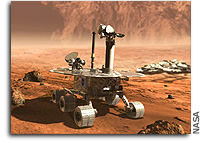Mars’ Dust Key Force On Planet’s Atmosphere, Surface Features Says Texas Researcher
 Texas A&M University researcher Mark Lemmon has
Texas A&M University researcher Mark Lemmon has
been selected as member of a science team for a mission to Mars next
year.
No, Lemmon won’t personally be visiting the Red Planet, but his
experiment will be part of the 2003 Mars Exploration Rover Mission,
consisting of two identical robotic rovers scheduled for launch in
mid-2003, to arrive at separate destinations on Mars in early 2004.
Part of the rovers’ mission will be to get a better handle on the
nature and accumulation and dissipation patterns of Mars’ signature
red dust.
According to most scientists who study the Mars, dust is the
defining feature of the planet’s atmosphere and may constitute the
major force eroding the planet’s surface, much like the role played
by water on the Earth.
"Understanding Martian dust will help scientists resolve a number
of issues, including the correct color of images sent back to
Earth," said Lemmon, a research scientist with the Department of
Atmospheric Science in the College of Geosciences. "A panoramic
camera will look at the landscape and sky, and possibly get a
glimpse of Martian dust storms and dust devils."
Lemmon, who while at the University of Arizona was also on the
Mars Pathfinder imaging team in 1997 and the 1999 Mars Polar Lander
science team, is hoping to facilitate scheduling of images such as
night-time pictures of Mars’ moons, Phobos and Deimos, including
photos of formation of morning fogs on Mars and shots of Phobos
eclipsing the sun.
"But one key part of my experiment focuses on measuring the amount
of dust in Mars’ atmosphere," Lemmon said. "That’s a tricky
measurement from Earth — when we look at Mars, we see a dusty
atmosphere on top of a dusty surface. Knowing where the dust is
helps us understand Mars’ weather and climate, since atmospheric
dust plays an important role in heating the planet’s atmosphere.
"Knowing about dust in the sky is also important to the mission,
since this dust blocks some of the sunlight that would fall on the
rovers’ solar panels and falls onto the solar panels, making them
less effective," he observed. "So the more we know about the dust,
the more we understand how much solar power we’ll have for our
instruments on Mars."
Lemmon’s work was one of 28 new projects chosen for inclusion in
the rover mission. In all, 84 proposals were submitted to NASA,
which chose those judged to have the best science value for
mission inclusion. All 28 investigators are part of the existing
Athena science payload team and will work with the rover project
at NASA’s Jet Propulsion Laboratory in Pasadena, Calif.
According to NASA officials, the rover mission has six science
objectives:
(1) study rocks and soils for clues to past ater activity;
(2) investigate landing sites that have a high probability of
containing evidence of the action of liquid water;(3) determine the distribution and composition of minerals, rocks
and soils surrounding the landing sites;(4) determine the nature of local surface geologic processes;
(5) calibrate and validate data from orbiting missions at each
landing site; and(6) study the geologic processes for clues about the environmental
conditions that existed when liquid water was present and
whether those environments were conducive for life.
Lemmon previously held a visiting faculty appointment in Texas
A&M’s Department of Physics.
"We are excited to have Mark join our department," said Jerry North,
head of the Department of Atmospheric Sciences. "Planetary
atmospheric research brings a new and exciting dimension to our
efforts."









